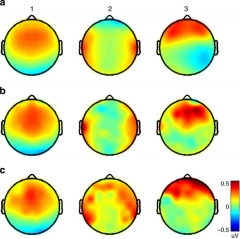Tweets, Viewers Predicted by Brain Studies
 A study with a rather opaque title, Audience preferences are predicted by temporal reliability of neural processing, has some interesting findings for the field of neuromarketing. Published in Nature, the paper found correlation between fMRI and EEG studies. And, the brain activity measurements correlated with real world viewership of TV programming and the number of tweets during the live broadcast.
A study with a rather opaque title, Audience preferences are predicted by temporal reliability of neural processing, has some interesting findings for the field of neuromarketing. Published in Nature, the paper found correlation between fMRI and EEG studies. And, the brain activity measurements correlated with real world viewership of TV programming and the number of tweets during the live broadcast.
The researchers, led by Jacek Dmochowski and Lucas Parra of the City College of New York, studied the reactions of “naive” viewers to the season premiere episode of The Walking Dead, a television series featuring menacing zombies. Other tests used that neuromarketing favorite, Super Bowl commercials. They recorded brain activity in subjects using EEG and, for some tests, fMRI.
The brain activity over time was then compared to viewership data from Nielsen (who is itself a provider of neuromarketing services via its consumer neuroscience unit, formerly NeuroFocus). The correlation between the brain activity of the subjects and the large-scale audience measurements was statistically significant.
A similar comparison to Twitter activity using the show’s hashtag found predictive value as well.

Predicting Ad Ratings
One of the interesting parts of the study showed subjects a random set of 10 Super Bowl ads while recording brain activity. Activity in specific regions showed significant correlation with large-scale audience measurements from Facebook-USA Today Ad Meter.
One quite surprising aspect was that the neural activity measurements were better predictors of the large audience response than in predicting the stated preferences of the experimental subjects themselves.
fMRI and EEG Comparison
Another clever experiment compared neural activity measured by fMRI to that of EEG. This phase also used Super Bowl commercials.
fMRI is the technique most often used by academic researchers, but its commercial use has been limited by the small number of available facilities and the high cost of using them. EEG is much less expensive and allows for larger sample sizes. They found covariance in some brain areas using the two techniques. Oddly, in that small test they found the fMRI not predictive of either the mass audience or experimental subject ratings of the commercials.
The scientists concluded with what sounds like an endorsement of the main principle of neuromarketing:
Our findings suggest that behavioural responses of large groups to natural stimuli may be robustly predicted from the reliability in corresponding neural responses of a small sample of individuals.
Commercial Conclusions
The good news is that brain wave measurements could predict the engagement level of the audience for the television content with some accuracy, as well as how well the mass audience would like advertisements. But, a bit of caution is in order for neuromarketers. Viewer engagement and likability are useful metrics and a great starting point, but they don’t tell a marketer whether content will create a brand preference or increase the intent to buy.
I also wonder about the choice of The Walking Dead as a test vehicle. This show has terrifying moments and gruesome imagery, and may not be representative of most entertainment content from a neural response standpoint.
Nevertheless, this study is good news for neuromarketing overall. Lead author Dmochowski is at Stanford now, a school that has already made significant contributions to the study of buyer behavior. (See, for example, The Pain of Buying.)
The conclusion that measuring neural responses from a small group of subjects can predict mass-market behavior may not be news to commercial neuromarketing firms, but is significant when published in a respected academic venue.
